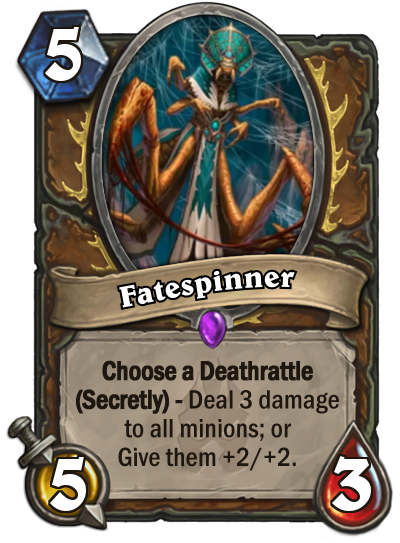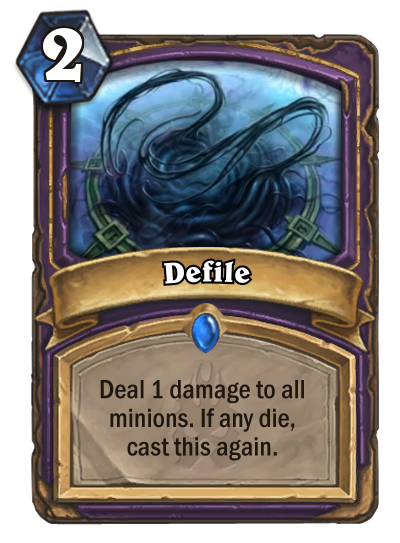
The word 'Curvestone' gets thrown at Hearthstone by those who seek to paint strategy in the game as nothing more than throwing down the most powerful creature you can afford to play on each turn. And while it's certainly true that plenty of good decks have done that, we've also seen archetypes like Patron Warrior and Miracle Rogue which required substantially more careful execution.
It's also fair to say that Blizzard has been painstaking about keeping card text and interactions as simple as possible, so as not to scare off the casual audience who just like to jam some games on the can during their lunch break. But with the release of next month's Knights of the Frozen Throne expansion, it looks like we're getting some substantially more complex cards than we've become accustomed to.
The precedent for greater complexity was arguably set in the previous expansion, Journey to Un'Goro, the most interesting card of which was the Priest minion Curious Glimmeroot, which asked you to guess which of three cards began in your opponent's deck. For Knights of the Frozen Throne, with around a third of the set revealed so far, things already look promising in terms of deeper design concepts. I want to highlight three cards that encourage greater strategic depth, beginning with a gnarly-looking spider:
Fatespinner

What's in the box?! In this case, the box being the spider's butt.
This new Druid card uses the 'choose one' mechanic which is unique to the class, but for the first time that choice is used to select a Deathrattle effect in secret. Both options are powerful, given that Druid traditionally lacks efficient board clearing effects when it's behind on board, and wants to buff its own dudes when its ahead. But the cute thing is going to be whether you dare trying to trick your opponent into making suboptimal plays.
On a contested board, they may assume you've gone for the AoE and so set up favourable minion trades first. But then it turns out you dump more stuff onto the board and get the buff. The most interesting scenario is going to be trying to guess what the Druid player has chosen when Fatespinner gets played on an empty board, and will again come down to knowledge of the matchup in question (ie what effect will they regard as most useful given how future turns are likely to play out) and good old-fashioned bluffing.
Defile

No in-game abacus = literally unplayable.
A big part of playing Hearthstone 'correctly' comes down to being able to calculate combat maths on the fly, trading as efficiently as possible so that you don't waste damage or end up losing creatures which you could have kept alive with another line of play. This new Warlock spell is 1) potentially insanely powerful, and 2) going to lead to both sweetly-calculated board clears and major maths mess ups.
The beauty of the card is that in order to extract maximum value from it, you need to create a board state that will lead to a domino effect that kills the other guy's creatures and (ideally) leaves your's alive. Doing that will require judicious trading with your own minions and the use of spells like Mortal Coil to tip the sums in your favour.
Keep up to date with the most important stories and the best deals, as picked by the PC Gamer team.
Corpsetaker

With smart deck building, this could become as ubiquitous as Piloted Shredder.
Once you take it all in, this neutral minion's effect isn't that hard to understand, but what I'm most interested in here is Blizzard's willingness to print increasingly sizeable slabs of text on cards. What Corpsetaker does is scan your deck looking for other creatures with the keywords listed, and if it finds them—bam!—the effect is copied when you play this onto the board. It's potentially going to be very spicy in Paladin decks that run Tirion Fordring and Wickerflame Bunrbristle, or Shaman decks with Al'Akir the Windlord.
Previously cards like Reno Jackson and Kazakus proc'd their effects based on whether your deck was built exclusively from singleton cards, but that concept is far easier to parse when written down. Fans have long argued that Blizzard should make more use of the fact Hearthstone is a digital CCG when creating new mechanics, and Corpsetaker definitely feels like that kind of thing. In a somewhat similar vein, there are also going to be three new legendary Prince cards in Frozen Throne which get bonuses if your deck doesn't contain any cards of a particular cost.
Without seeing the whole set, quite how viable these concepts end up being is anyone's guess—but you can bet plenty of people are going to experiment with these concepts, because let's face it: they're more interesting than just slamming a Bloodsail Raider down on turn two. Though that of course carries it's own dread appeal.
With over two decades covering videogames, Tim has been there from the beginning. In his case, that meant playing Elite in 'co-op' on a BBC Micro (one player uses the movement keys, the other shoots) until his parents finally caved and bought an Amstrad CPC 6128. These days, when not steering the good ship PC Gamer, Tim spends his time complaining that all Priest mains in Hearthstone are degenerates and raiding in Destiny 2. He's almost certainly doing one of these right now.


